Excerpts from Jim Conrad's
Naturalist Newsletter
from the April 24, 2011 Newsletter issued from Hacienda Chichen Resort beside Chichén Itzá Ruins, central Yucatán, MÉXICO
A BIG INDIAN-FIG CACTUS IN FLOWER
While biking backstreet Pisté last Sunday I came upon the large Indian-Fig cactus shown below:
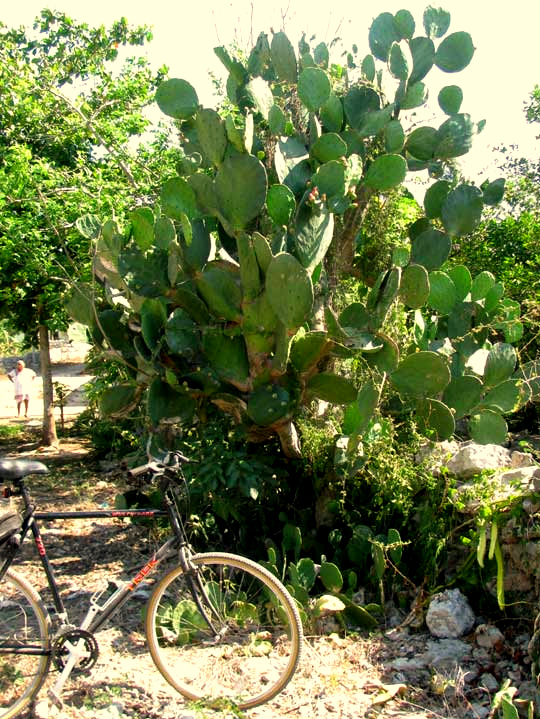
A picture of my hand next to a big pad, so you can get a feeling for how large a pad can get, is shown below:
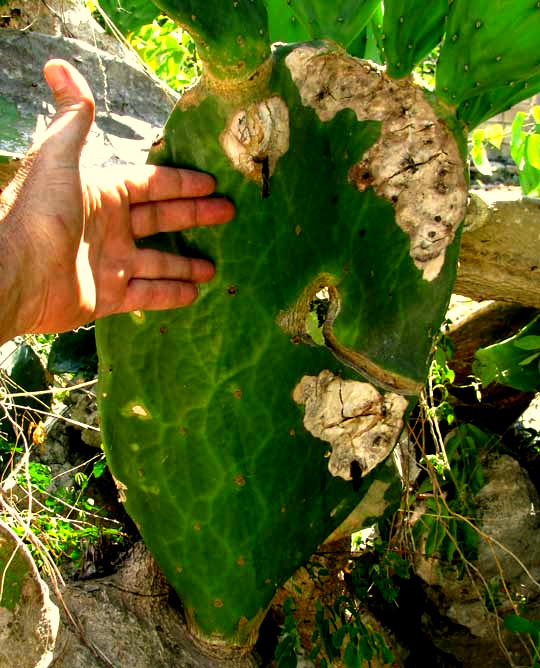
The cactus bore about half a dozen flowers, one shown below:
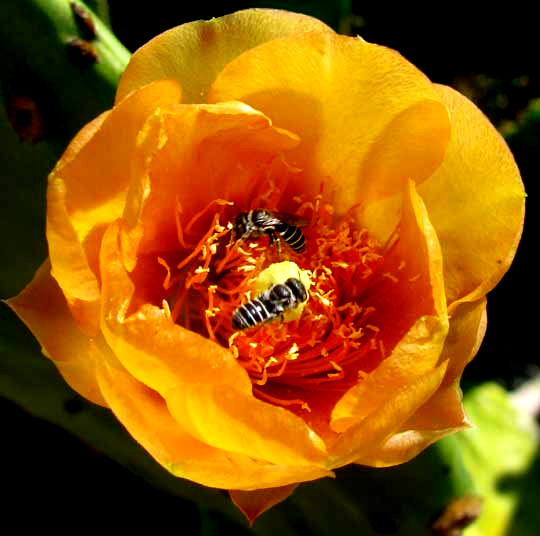
In that picture the pale yellow item in the center, with a bee atop it, is the stigma terminating a particularly thick style (the ovary's "neck"). The many slender things surrounding the stigma are stamens. Then of course there are the yellow petals. These are all typical features of flowers of the genus Opuntia, commonly known as the prickly-pears. Another typical feature is how the numerous, basically green sepals grade into the colorful petals, as shown below:
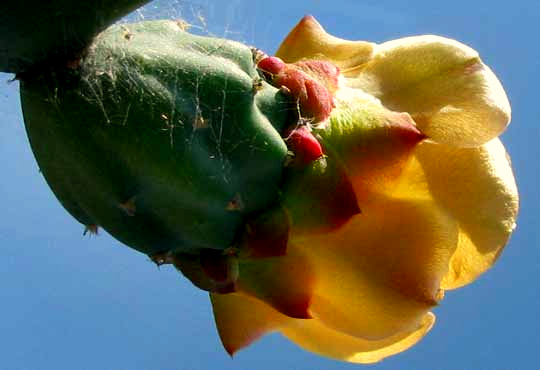
In that picture, the red-tipped items are the sepals. In the Cactus Family flower, ovaries are " inferior," which means that sepals, petals and the rest arise atop the ovary, not at its base. Thus in the picture the green, egg-shaped part below the sepals and petals is the ovary, which will mature into the edible tuna fruit. So few flowers graced this big plant that I'm guessing that it was an old one.
Indian-Figs are the main source of edible cactus slivers, or nopales, though the pads of most species of prickly-pear cacti also are edible. Indian-Figs are mainly chosen for food because of their relative spinelessness.
Mexico is home to more cactus species than any other country, so it's assumed that the first cacti arose here. However, our Indian-Fig is so widely planted throughout the world's tropical zone that it's not clear where the species originally was native.
from the December 18, 2006 Newsletter issued from Sierra Gorda Biosphere Reserve, QUERÉTARO, MÉXICO
HOW PANCHO OPENED HIS TUNA
Up at San Juan de los Durán there was this Nopal Cactus, OPUNTIA FICUS-INDICA, about 12 feet tall behind one of the bungalows bearing several pretty, red fruits, or tunas, which taste good. You can see that very cactus below:
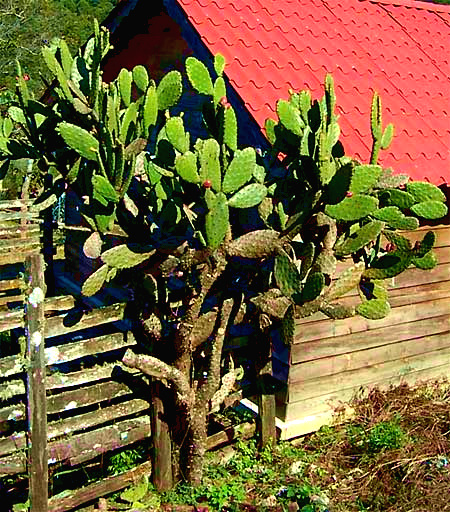
Now, many cactuses bear two kinds of spines. One kind is the hard, sharp spine everyone visualizes cactuses having, but then there are tufts of often honey-colored, extremely sharp, tiny spines called "glochids" at the spine bases or where spines might grow. You touch one of those glochids and you end up picking at it for days trying to get it out of your skin. You almost have to have good eyes and tweezers to get those things out. A close-up of two tunas in which you can clearly see the glochid tufts with no associated spines is below:
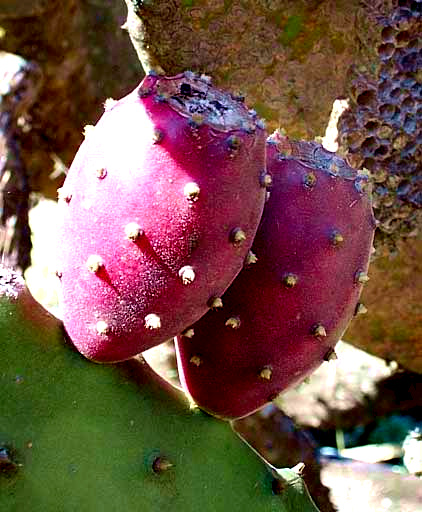
The tunas in that picture are about egg-size, but in markets you can buy special horticultural kinds that are much larger and without glochids, or almost without. The Nopal Cactus has been horticuluralized for so long that quite a few varieties have been developed. The cactus in these pictures is an old type.
So, I had a good-tasting fruit covered with glochids I didn't want to touch. How could I get at the edible part without ruining my fingers for several days? I've tried various techniques and I've always ended up with at least one glochid in a finger, so up at San Juan de los Durán I didn't even try to open a tuna.
However, my friend Pancho, the truck driver, eventually came along so I asked him how he'd eat it. He gave me that look that only a Mexican can give a gringo when the gringo is being hopelessly helpless. He took a fruit between two sticks chopstick-like, and told me to follow him. We went over to the bunch of weeds near the spring where the Rufous-capped Warblers had tarried, dropped the tunas onto the ground, broke off several switches from an assortment of soft-leafy weeds, and set about vigorously brushing the tunas with his weed-switch. After about 45 seconds he picked up a tuna with his fingers, sliced it open, and held it before me to eat. Before I ate it I took its picture, which you can see below:
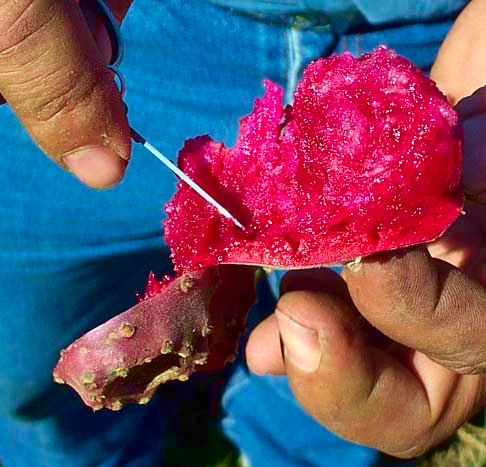
And, indeed, Pancho didn't get a single glochid in his finger. Through all these years of wandering in cactus country, why hadn't I thought of switching tunas with soft-leafy weeds?
The picture shows that tuna fruits are red and succulent inside, looking almost like watermelon flesh. The taste is even a little like watermelon. However, the scarlet pulp is full of small seeds, so you're faced with the same question as when you eat passion fruits or pomegranates: Do you spit out each little seed or swallow them?
I asked Pancho what Mexicans did. He said that some spit, some swallow. He, personally, was a swallower. By the time he'd told me all that I'd already swallowed mine.
from the March 17, 2007 Newsletter issued from Sierra Gorda Biosphere Reserve, QUERÉTARO, MÉXICO
NOPAL AT THE WINDOW
Monday morning I was working in my little casita when someone outside by window loudly said "¡Buenos días, buenos días... !" I parted by curtains and there stood Don Gonzalo with his usual big smile. He'd brought me a plastic bag of Nopal cactus pads ready to turn into the delicious dish called "nopalitos." You can see those very pads moments before I sliced them up below:
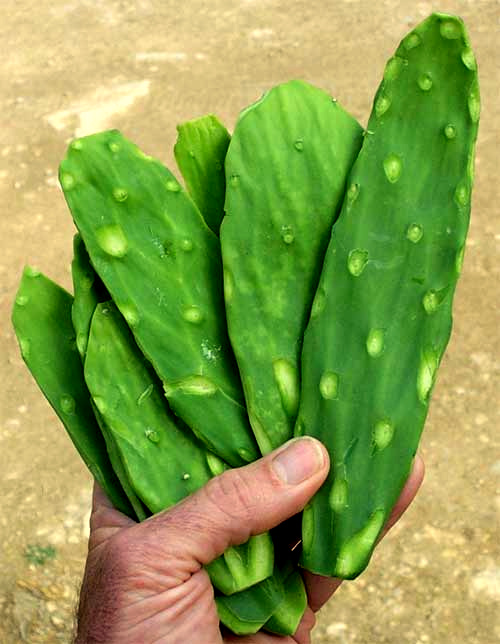
In that picture you can admire the conscientious job the don did preparing the pads. He chose young pads still in their long, slender, tender stage, he shaved off every bump on each pad where there conceivably could be a glochid -- one of those tiny, almost invisible stickers at the base of normal spines -- and he'd excised the rims, which are the toughest parts, and where there'll be glochids if there's any glochid at all. I was touched, for it takes a little time to prepare cactus pads like this.
When I made my own napalito dish all I did was to cut my pads into my black solar-oven bowl, top them with chopped onions, sliced jalapeños and two raw eggs. When this had cooked to the point that the nopal pieces were soft and a little slimy, the onions were smelling awfully good, and the jalapeños hadn't yet lost their sting, I topped it all with chopped tomatoes, salted lightly, and spritzed it with a little vinegar and oil.
from the January 1, 2012 Newsletter issued from Hacienda Chichen Resort beside Chichén Itzá Ruins, central Yucatán, MÉXICO
CACTUS LEAVES
I planted some Nopal Cactus, OPUNTIA FICUS-INDICA, in front of the hut so visitors can learn about it. The pads quickly rooted and now their upper pads are sprouting what later will become new pads, as seen below:
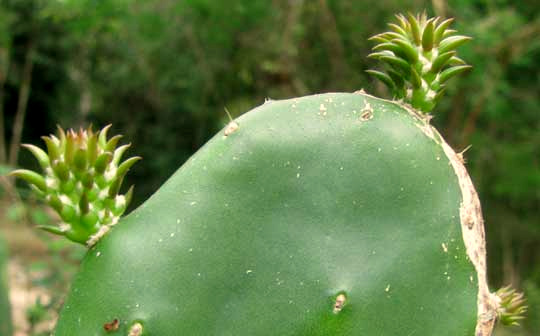
One of those pineapple-like sprouts is shown close-up below:
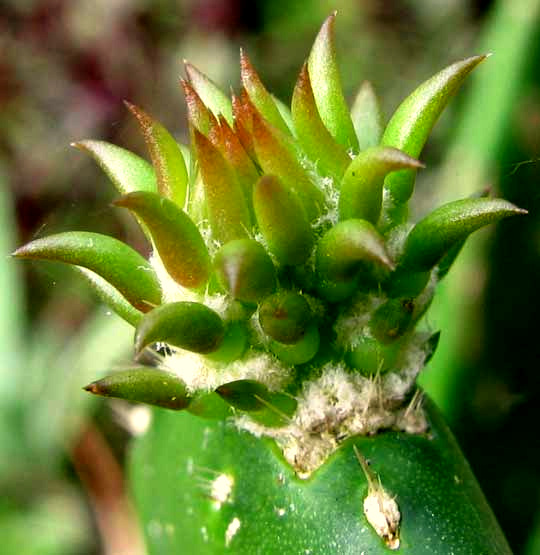
The green, sharp-pointed, recurved items are leaves. They're the only leaves this cactus has, and in a few days will fall off. From the cactus's point of view, these leaves are mostly vestigial and apparently don't do the cactus much good. The first cacti bore flat, broad, much larger leaves that performed the same services as regular leaves do for regular plants today. However, during evolutionary history the vast majority (not all) of cactus kinds found it more adaptive to lose their leaves than to retain them. Still, recent studies show that cactus genes retain all the information needed to produce the complex plumbing and chemistry of regular leaves, but that information is "turned off."
In most cacti, including the Nopal, photosynthesis is performed in the cactus pads, which are modified stems, not leaves.
In our picture notice that the lower leaves appear to reside atop tiny, green platforms. I'm not sure whether the platforms are vestigial leaf stems, or petioles, but you can see what happens to them a few days after the cactus pad has enlarged a bit below:
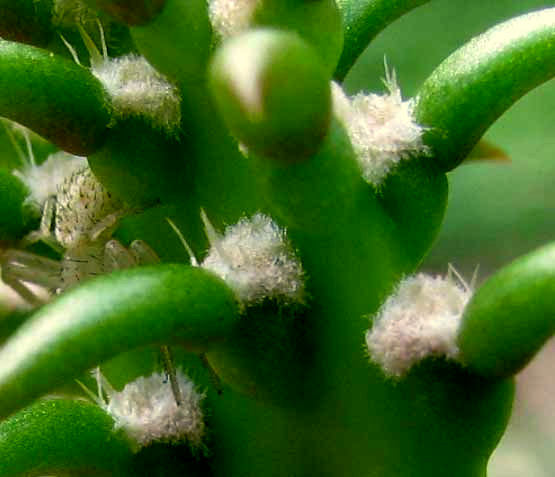
Basically the bases widen as the pad expands beneath them. By the time the conical leaves fall off, they've practically spread until they've merged into the pads, leaving hardly a trace.
Many if not most cacti can be eaten if the spines are removed, and the wonderful thing about Nopal is that it produces few or no regular spines. However, cacti produce two kinds of spines, big ones and tiny ones, and even Nopal bears some of the tiny ones, which are called glochids. In the picture you can see some. Touch your fingertip to them and they'll come off and you'll want tweezers for removing them.
Entry dated August 15, 2023, issued from near Tequisquiapan, elevation about 1,900m (6200 ft), Querétaro state, MÉXICO
(~N20.57°, ~W99.89°)
"OPUNTIA MAXIMA"
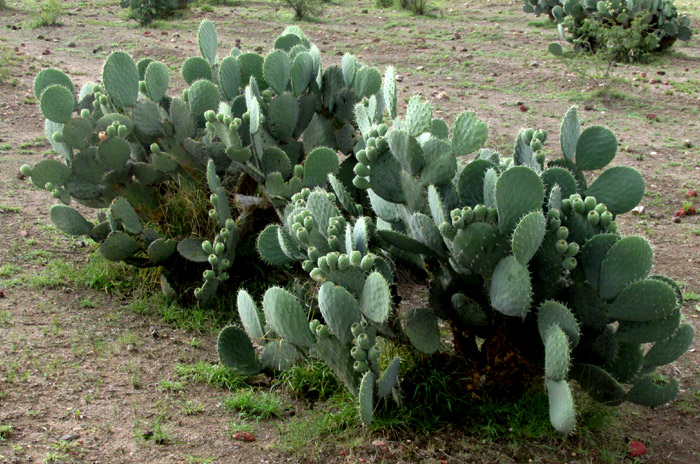
In a grossly overgrazed pasture near a small village, the above pricklypear cacti, genus Opuntia, apparently had been planted, but not cared for. That seemed the case because they grew in rows, on low ridges, but were randomly distanced from one another in the rows, as if most had died or maybe been eaten by cattle after being planted. They're unlike pricklypear species growing wild here, in that they produce almost no trunk and their pads produce many more large fruits, or tunas.
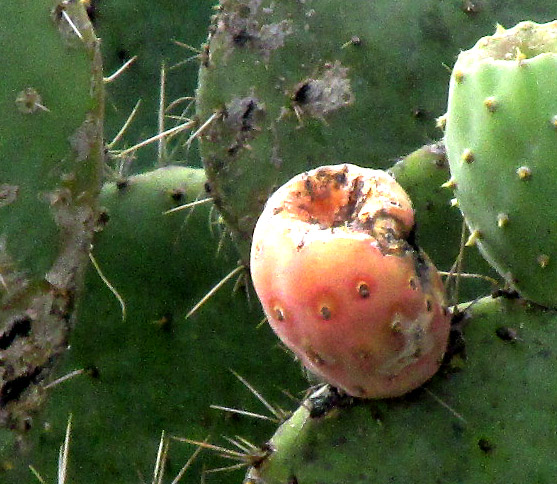
As seen above, the fruits tend to be pale rosy below but with whitish tops. They're practically spineless, but do bear tiny glochids which stick into fingers if not handled carefully. Below is a picture of another, larger plant in the same field, taken a year earlier and in July, earlier in the season and before the fruits began turning rosy. It gives a better idea of the cactus's prodigious fruit production:
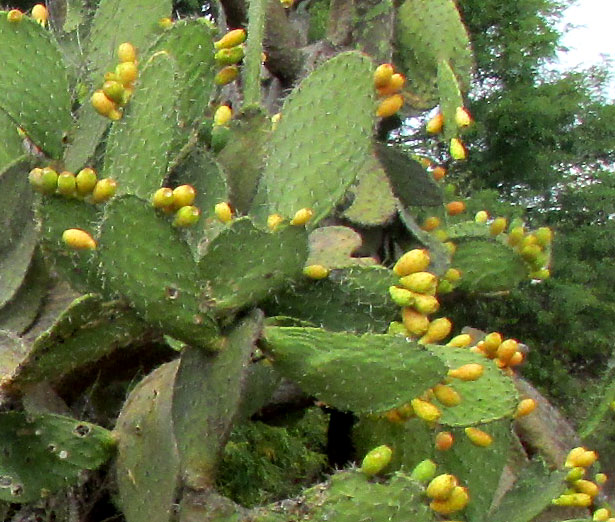
Here's a closer look at the spines, which often tend to bend so that they lie close to the pads' surfaces:
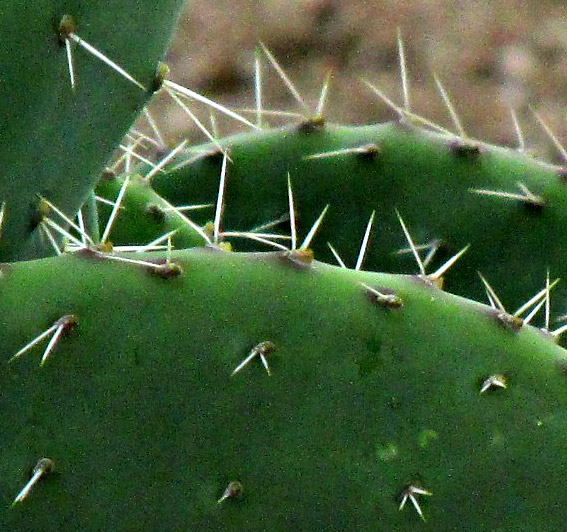
The local people collect these fruits as soon as they turn the colors shown above. Woodpeckers like to eat them. Here the fruits, or tunas, are fed to livestock, and so far I've seen no human eat them. The fruits are especially important now because of our long-enduring drought, which has resulted in bad grazing.
Above, quotation marks are placed around the name Opuntia maxima because of disagreement about what these cacti are called. Plenty of pictures on the Internet matching our plants are labeled as Opuntia maxima, but most of those pages deal with plants of southern Europe, where the taxon has escaped and become a conspicuous presence, often an unwelcome one. Usually these page give the country of origin as Mexico. In Spain, Royal Decree 630 of August 2, 2013 prohibits the introduction of Opuntia maxima, its possession, transport, traffic and sale.
Plenty of images of the same taxon also can be found identified as Opuntia amyclaea, and usually they're those pages are produced by Mexicans. Also, sometimes images exactly matching ours are labeled Opuntia ficus-indica, the name for the extremely variable, much cultivated nopal pricklypear, or Indian-fig.
At this writing, the Kew Plants of the World Online database, which so far seems to me the most frequently updated and authoritative place to check the status of plant binomials, accepts the name Opuntia maxima, and describes its native distribution as central and southwestern Mexico. It also lists Opuntia amyclaea as a synonym of Opuntia maxima. However, the GBIF database and The World Flora Online database, both also regarded as authoritative, describe Opuntia maxima as a synonym of Opuntia ficus-indica, and thus just a form of the Indian-fig's many manifestations, not even a subspecies or variety.
My instinct, after seeing so many forms of Opuntia ficus-indica, is that this is yet another form.